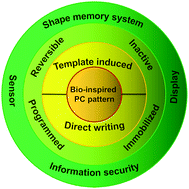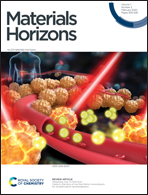Bio-inspired photonic crystal patterns
Abstract
Biological photonic crystal (PC) patterns provide unique functionalities for the survival of creatures, such as the static identified patterns of butterfly wings, the mating function of the eye pattern of peacock feathers and the dynamic warning effect of the changing colour of a chameleon upon external stimulus. Inspired by these special functionalities, patterned PCs have been developed and have attracted considerable research interest due to their potential applications in sensors, catalysts, displays, information security and other fields. This review summarizes the preparation strategies, functional evolution and applications of patterned PCs. First, a series of preparation strategies for PC patterns are summarized, including template-induced assembly and direct writing without a template. Subsequently, the research progress in patterned PCs is sorted based on the evolution of their functionality, such as inactive and responsive (reversible, immobilized and programmed) PC patterns. Various applications of patterned PCs are also described in detail, such as sensing devices with a high sensitivity and fast response, PC displays based on external field regulation, information security anti-counterfeiting devices and shape memory intelligent systems. Finally, the outlook and challenges regarding PC patterns are presented. This review provides a significant foundation for the construction of new functional materials based on patterned PCs.

- This article is part of the themed collections: Recent Review Articles and 2020 Materials Horizons most popular articles


 Please wait while we load your content...
Please wait while we load your content...